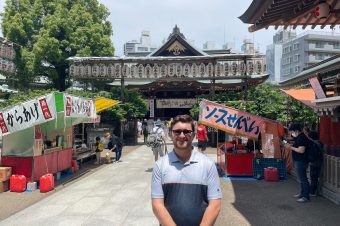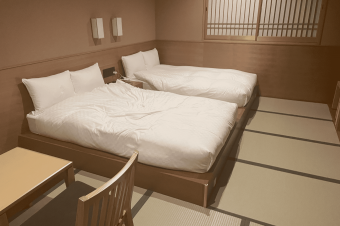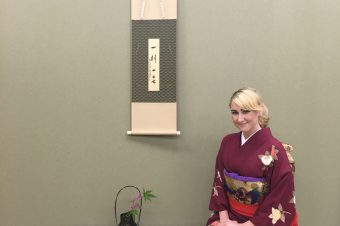Sitting cross-legged on the ground and looking down, half focusing on the black line that runs across the floor, I catch out of the corner of my eye the Buddhist priest’s movement. His barefoot feet make muted sound on the tatami mat floor as his wooden keisaku stick rests in his hands. When he passes in front of me, I put my hands together and put them against my chest. He halts in front of me, and we bow to one another. I then cross my arms, my hands on my shoulder, and lean forward, exposing my back. He lightly places the keisaku on the left side of my back, feeling for the muscles between the spine and shoulder blade. I feel the stick lift and then…
Whack
Whack
A small pause to find the right place on the other side of my back
Whack
Whack
I lift my head back up, the sting of the stick having already dispersed, and bow again to the priest. He continues to his next grateful victim.

To explain this seemingly strange scene, I’ll need to describe zazen. Zazen is a meditation practiced by the three Zen Buddhist sects in Japan and all over the world. Priests and commoners alike practice zazen as a method of relaxing and resetting one’s mind. Practitioners often do it daily, not unlike brushing your teeth or combing your washing your hair. Just as those hygienic routines are important for a person’s physical health, zazen meditation is important to a practitioner’s mental health. It can be done sitting or standing, alone or in a group, and at home or at a temple.

I experienced a group zazen session, with a priest guiding us through the process. Buddhist priests like him are experts in zazen; as a part of his training in being a Buddhist priest he done zazen for hours at a time. We were seated on cushions while he explained to us the way to do zazen and its purpose. Here is some of the things we were told and what my experience trying them felt like.

Posture
Traditionally, zazen is done cross-legged in either a Kekkafuza (full lotus) or Hankafuza (half lotus) posture. I could only force my legs into a half lotus, but I found it was too painful to maintain, so I went ahead and sat cross legged. The hands should be in the position pictured. You should be sitting straight up. The position, especially if you’re as inflexible as me, is rather painful if you don’t take small breaks.
Focus
When you meditate, your eyes should be looking down towards the ground. Because my eyes were angled down, I quickly began to feel as though I was in between sleep and consciousness. This is the feeling that you’re trying to feel, because it is best to be able to accept your surroundings while also in a different state of mind.
Counting
I had never meditated before and so I quickly became acutely aware of a simple fact: my mind is constantly racing. I don’t think I’m unique in overthinking; everyone in this busy world has worries from the past and for the future. So, how do you clear your head to arrive at the correct relaxing meditation. To solve this problem, the priest told us to focus on our breathing and slowly count to ten over and over. This counting is meant to clear your head and force you to focus on the present.
Keisaku
The weapon (stick) I described being struck with is called a keisaku. Its purpose is to wake meditating priests up during long sessions and help to restore concentration. The priest showed us how it works for us to experience. You bow to the priest as you are being “given” the strikes. The stick, despite its rather loud whack, does not hurt.
Kyoten
In between the two blocks of time that we meditated, the group stopped to chant some sutras. My Japanese is very limited and the kyoten’s words are extremely difficult even for native speakers to understand, so although I could chant along, I had no idea what I was saying. Even so, there were repetitions that seemed to lull me into the meditative state of mind. I realized that the meaning didn’t matter quite so much as this fleeting feeling.
Purpose
The purpose of zazen is both relaxation and clearing the mind. This famous parable highlights a part of the “point” of zazen: a Zen priest is talking with a professor who had come to ask about Zen. The priest pours the professor tea but continues to fill after it is full. The professor tells him to stop and that he is spilling tea everywhere. The priest then makes a comparison to the man and the cup; just like the priest can’t fill the cup anymore than it already is, he also can’t more ideas into a man already full of them.
This exemplifies a part of the point of zazen. We are constantly filled with ideas that make it impossible to process new information. Work, family, and random bumps in the road of life all combine to add to a person’s stress. By stopping and focusing on the here and now through zazen, a person can see with fresh eyes.





